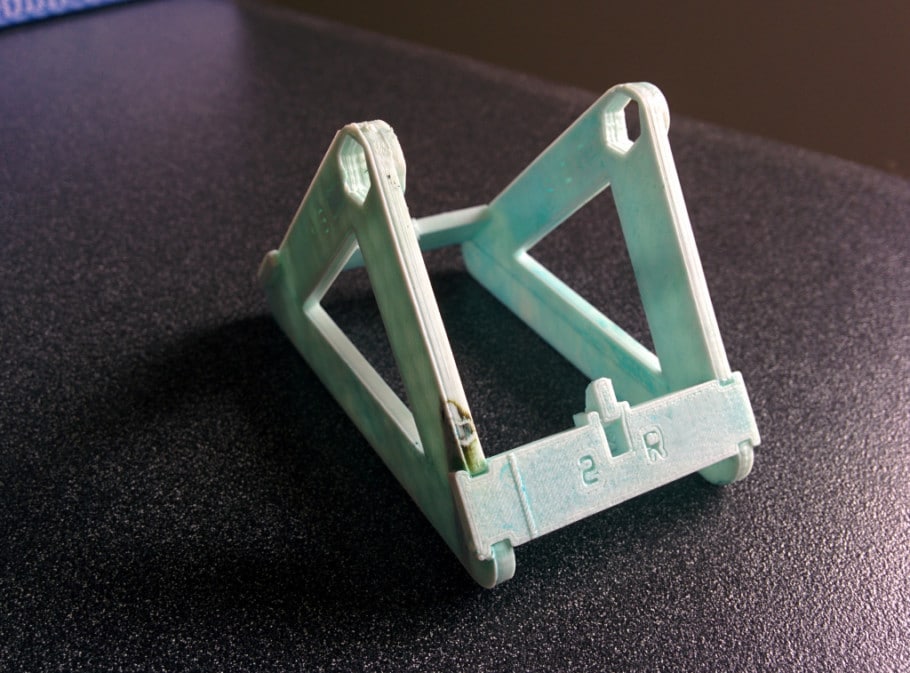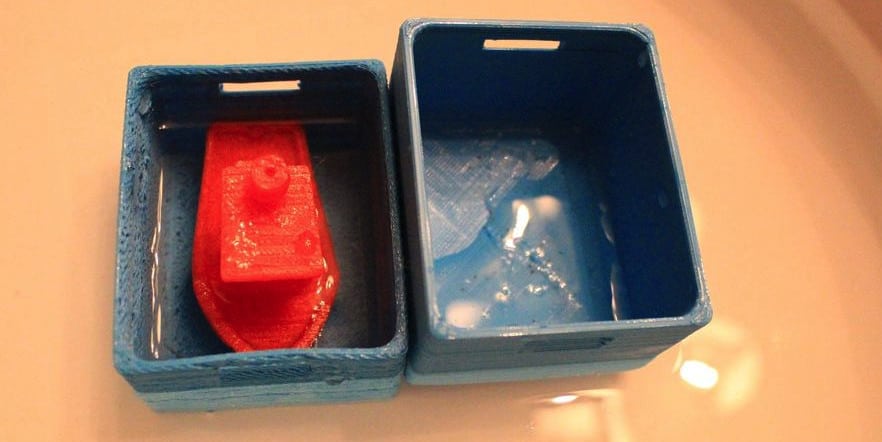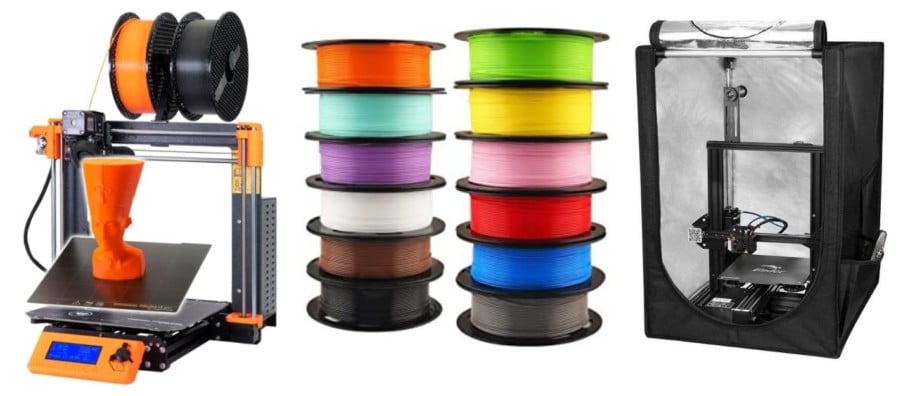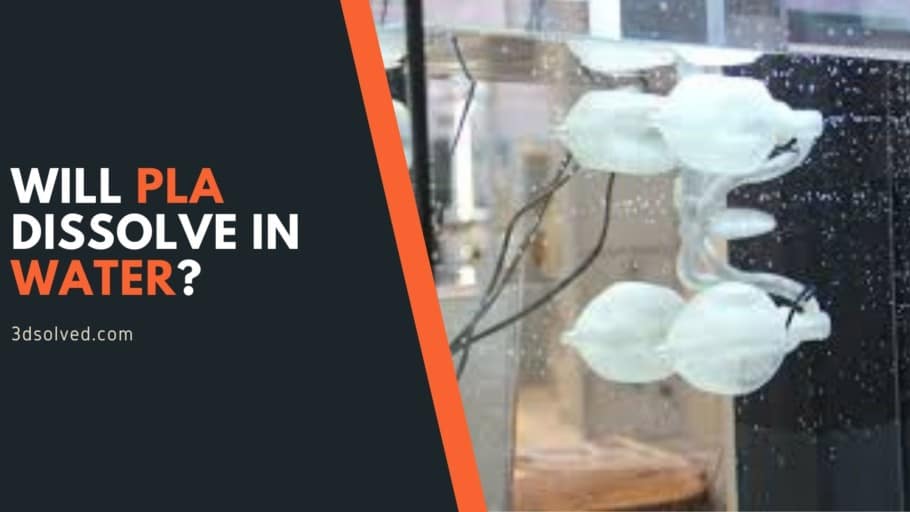There’s a lot of information out there regarding this topic, and the truth of the matter is that it depends on a lot of conditions, since in some cases PLA will become brittle and break down fairly quickly, while in some others it will last for years underwater without getting damaged at all!
In this article, I will go over if PLA will dissolve in water, what conditions need to be met for this to be the case, if it absorbs water, and how you can make it waterproof, if at all. But here’s the short answer if you don’t have time to read the whole thing:
In order for PLA to dissolve in water, a lot of conditions have to be met, such as a high water temperature, exposure to UV light, and the presence of specific biological activity in the water. In most cases, PLA won’t break down or become brittle in water for years unless the temperature of the water is relatively high and or if sunlight is able to come in contact with it.
Will PLA dissolve in water?

PLA is a type of bioplastic. It is made from potatoes, corn, rice, and other similar plants and vegetables. Although it is water-resistant, it is not like other plastics made from petrochemicals which can last in water for 500-1000 years. PLA breaks down much more quickly in water than traditional plastics, and that breakdown can be sped up by certain environmental conditions.
Environmental variables that will influence how much a PLA 3D print dissolves in water include filament brand, processing additives, biological activities, and external variables including UV light, temperature, and the oxygenation of the water itself.
Pure water will not affect PLA prints. However, under the above mentioned conditions, it will start to degrade at a much quicker pace than other plastic types.
In addition to this, organic matter like bacteria and inorganic materials like mineral salts degrade the polylactic acid (PLA) polymer chains in impure water, causing them to break down into much smaller chains called monomers. When the plastic gets to that size, microorganisms can start to eat it, which is actually called composting but is commonly mistaken as “dissolved in water”.
Therefore, if the necessary conditions or chemicals needed to decompose the biodegradable PLA are not present in the environment, your PLA prints will never be affected by water.
At worst, it will swell since PLA, as well as most other filaments, is hygroscopic, meaning that it absorbs water. The bright side to this is that it can be dried, either in the oven, using a food dehydrator, or a filament dryer and this will bring the filament roll back to its original state.
Does PLA Absorb water?
PLA filament is mildly hygroscopic, which means that it absorbs water (I say mildly because it does so slower than other filaments). This means that both the filament and the finished prints will swell up and become brittle over time. In order to avoid this from happening, you should store the PLA in plastic containers or ziploc bags with silica gel packets.
PLA absorbs water and will weaken slightly when it does. The more moisture in PLA, the weaker it will become. A wet PLA print will have a rougher texture and more imperfections like blobs, bubbly texture, and stringing. It will become brittle and lose flexibility which means it will be more likely to break and less likely to bend. The adhesion between the individual layers of the print will also be compromised.
This is also why you don’t want to print with PLA that has been sitting in a humid room, since the printing process itself will be compromised and the results will be far worse.
So, always try to store your filaments properly, either in a sealed bag with moisture absorbers, or in a specially designed storing box.
How to make PLA Waterproof

I’m going to tell you four ways you can waterproof your 3D prints.
1) Print thicker layers (Use a larger Nozzle)
Printing with a larger nozzle means that the contact surface area between the layers will be larger, especially if you use a really low layer height. See for yourself in this image:

If the layers themselves are wide and the layer height is low, then there will be much fewer spots for water to get through. As a bonus, your print will be stronger as well!
2) Over Extrude
Overextruding is an effective way to waterproof your print, but it does considerably reduce the visual quality of the outer shell.
You can waterproof 3D prints by slightly over extruding the filament when printing. It allows the filament to bond better with previously printed layers. It also works well with prints that were printed at a higher temperature as the layers are more likely to adhere to each other.
This solution may not work for you if you’re creating a product that requires very precise dimensions and that needs to look polished.
3) Add More Perimeters
Increasing the perimeters or shells of your model will waterproof your 3D print better without significantly impacting visual quality. It is possible to prevent leaking altogether by adding an additional 4-6 shells as they will create a strong barrier.
4) Print Less Complex Models
You can waterproof your 3D models very effectively by simplifying their geometry during the design process. The more intricate or complex your 3D print, the more possibilities there are for some imperfections to appear, and therefore there might also be more places for water to leak through your print.
Simplifying your model will help waterproof it and at the same time make it stronger, easier, and faster to print. When you have overhangs, sharp corners, or complex details in your design, there’s more room for error in terms of gaps and layer adhesion.
5) Use wax to make the Print Waterproof
Wax can help make your 3D print watertight, and you don’t really need any specific kind of wax, even crayons will work.
Make sure to clean the surface of the print using a small brush, then use a heat gun or a double boiler to melt the wax, or any other object you can think of that would melt it, and then using a brush apply it on the print.
After doing this, let it sit for a couple of minutes until the wax has completely cooled down to finally remove the excess wax with the brush.
If done correctly, your print should now be watertight.
Can you use PLA objects in Fish Tanks?
PLA is a bioplastic. It is non-toxic, making it an appropriate choice for use in your aquarium, but there are some important factors to consider when using PLA filaments in aquariums to minimize harm to your fish or other aquatic pets.
PLA itself is safe, some PLA manufacturers, however, use dangerous additives which can jeopardize an aquarium’s ecosystem. If you want to prevent PLA prints from putting dangerous chemicals in your tank you should avoid printing with PLA that’s not marked food-safe or that has not been reviewed appropriately for aquarium use.
Don’t print using any PLA filament that is a composite of materials like flex PLA, glow-in-the-dark and wood-fill. Choose the natural PLA or white PLA (which is clear and has a slightly yellow tinge).
PLA is biodegradable, so it will eventually decompose and the PLA plastic will break down and crumble away over time due to the unique conditions of the fish aquarium. This is especially true for saltwater tanks.
A 3D print made from PLA needs post-processing to keep from completely breaking down, such as waterproofing. Post-printing treatments are important for protecting the prints from decomposing. They also give them proper surface finishes.
As I mentioned, I’d recommend going with a neutral color for PLA, such as white, since it won’t jeopardize the fish’s health.
Conclusion
Some people claim that in just two or three weeks, your PLA prints will completely break down in water. But there definitely is a lot of controversy surrounding this topic.
While PLA will become more brittle over time, this is mostly caused because of UV radiation, and not because of it coming in contact with water, unless the water is sitting at around 70 degrees Celsius. In this case, the prints break down quite fast!
So, essentially you can create prints out of PLA and use them in water, so long as they don’t get hit by sunlight all day long. I’ve seen PLA prints survive for over three years in water without any noticeable decomposition.
I hope this information was useful!
Have a wonderful day!
Check out our recommended products section

We created a recommended products section that will allow you to remove the guesswork and reduce the time spent researching what printer, filament, or upgrades to get, since we know that this can be a very daunting task and which generally leads to a lot of confusion.
We have selected just a handful of 3D printers that we consider to be good for beginners as well as intermediates, and even experts, making the decision easier, and the filaments, as well as the upgrades listed, were all tested by us and carefully selected, so you know that whichever one you choose will work as intended.
Error processing API data.

Good post. PLA cannot dissolve in water, but water could speed on the decomposing process, it is a very slow speed.
I printed some PLA wheel bearings for my swimming pool cleaner.
So far there has been very little wear and no obvious water absorption.
At the time of posting it has been in the pool for 14 months.
These bearings have been constantly in the pool water I do not take the cleaner out.
Thank you for your article
I have had a part near the heater partially decompose within a year. But today, about a year in, a cool part is broken as well, thin walled but out of UV and seemingly unstressed. Several other parts show no wear. Yet.